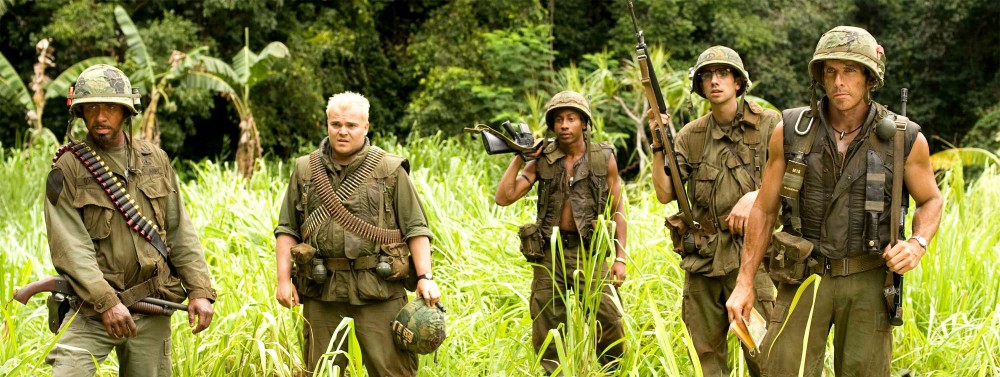For this blog Post I will be writing on Tropic Thunder. I was thrilled when Dan told our class that we would be watching this movie. It has got to be one of my top 50 favorite movies of all time. I think that this film’s use of satire is genius. It uses satire to point out so many things that are wrong with modern day Hollywood. There are two particular things that I want to point out that this movie does really well. The first thing is how the film’s use of Robert Downey Jr. and Brandon Jackson to point out stereotypical black representation in the majority of Hollywood films. Robert Downey Jr.’s character, Kirk Lazarus, is used throughout the film by director, Ben Stiller, to question the stereotypical black man often portrayed by hollywood. He is loud, outspoken, and is often times caught using “hip” terms and slang and metaphor to communicate to his fellow cast members. Lazarus, being a white actor portraying a black man allows for the audience to easily identify when Lazarus is trying to “act black” when he begins sentences with “A yes uh” and when he talks about collard greens. Brandon Jackson also does a great job of pointing out this stereotypical black role used by Hollywood. Throughout the movie, Jackson’s Character, a overly masculine, womanizing, rapper named “Alpa Chino”. At the beginning of the film, Stiller introduces Jackson surrounded by booty shaking woman, rapping, and selling his new beverage “booty sweat”. I think that Stiller uses Jackson’s character as a second example to point out, in a comedic way, how Hollywood portrays black men.
Throughout the film, Jackson’s character is often stopping Lazarus and questioning the “black” remarks he makes during the film. Chino’s questioning allows the audience to see that a “real” black man is frustrated by how Lazarus thinks he should act when portraying a black character. Later in the film, Stiller uses Chino again to point out the black male stereotype. During the scene around the fire, Chino is found out to be gay. When questioned by the other characters, he tries to deny his queer sexuality. I think that this part of the film, Stiller is showing how a black character does not have to to be straight and hyper masculine. The other characters reaction of sheer shock upon finding out Chino’s sexuality further highlights to the audience what is expected out of a black character in a Hollywood film.
The second part of this film that I want to point out is the “full retard” scene. I don’t agree with the way this scene was worded, but I agree with what Lazarus was telling Speedman in the film. I think that when an actor tries to act as a mentally ill person, it makes it really hard for the audience to watch and sympathize with the actor. I think that it almost feels as if the actor is making fun of people that are mentally ill. Lazarus points out the movie, “I am Sam” and Sean Penn as going “full retard”. In the film the Rain Man, Dustin Hoffman plays an man that seems to have autism. The difference between “Rain Man” and “I am Sam” is that Dustin Hoffman, in “Rain Man”, highlights a attribute of his character, his strong memory and ability to count cards. This makes Dustin Hoffman’s role into his ability to tell a story to an audience about a person’s magnificent gift and how they use that gift to fight the everyday struggles that come with being mentally disabled.
